Endangered curlews get a head start
Curlew recovery project rescues eggs from East of England’s airfields.

A man and a women look at a curlew egg collected from an airfield.
The endangered Eurasian curlew is being given a helping hand thanks to a recovery project getting underway today in Norfolk.
The project which builds on a successful pilot project last year, rescues eggs laid by the curlew on airfields before incubating, rearing and releasing them in habitats where they have the best opportunity to thrive.
The curlew is Europe’s largest wading bird and has suffered a severe decline in population over the past 40 years.
The eggs collected by Natural England staff and partners are now starting to hatch at Pensthorpe Natural Park and WWT Slimbridge. Later this summer, the fledged curlew will be tagged and released at Wild Ken Hill and Sandringham Estate in Norfolk, while the birds raised at Slimbridge will be released on Dartmoor.
This year more GPS tags and radio transmitters are being fitted to the birds to boost efforts to track their movements and conservation.
As a ground-nesting species, curlew gravitate to airfields which mimic the natural open grasslands they prefer, while security fencing at airfields can also help deter predators such as foxes. However, curlew nesting close to runways pose a danger to air safety and, until this project began, eggs laid on airfields would be destroyed under licence to prevent the risk of collisions between aircraft and birds.
Graham Irving, Wildlife Management Lead Adviser at Natural England, said:
At Natural England we want to see nature thriving everywhere. The decline of the curlew is one of England’s most pressing conservation challenges and we’re proud to be leading this innovative project, which we hope will make a significant difference to the fortunes of this iconic bird in the east of England.
Chrissie Kelley, Head of Species Management at Pensthorpe Conservation Trust, said:
Working together is vital to help reverse the decline of the curlew. Pensthorpe Conservation Trust are thrilled to play a significant part in aiding the recovery of such an important species, by rearing and releasing chicks saved from the airfields. This, along with changes to the management of their habitat, we and the partners of this project hope to safeguard the future of the curlew.
Air Commodore Sam Sansome, Inspector of Safety RAF, said:
The RAF is so proud to be supporting this fantastic project again this year. It really is an amazing thing being done by the team and it is brilliant that all the organisations involved have pulled together, again, to ensure the future of this iconic bird.
Joe Hamer, Ecologist at the Defence Infrastructure Organisation, said:
DIO is proud to be a small part of the continued success of this important project. It shows that by working with partners across numerous organisations, we can make a positive change and learn important information about curlew habits at the same time.
Staff from Natural England, Pensthorpe Conservation Trust (PCT) and the Wildfowl and Wetlands Trust (WWT) have been working closely with the Defence Infrastructure Organisation and the Royal Air Force to collect eggs from military and civil airfields.
The work which will continue into the summer follows the first year of the Defra-funded project in 2021 which saw 79 young birds reared at Pensthorpe and released in Norfolk.
Their progress has been monitored by the British Trust for Ornithology (BTO), who fitted colour rings to all birds while also fitting some with satellite or radio tags giving a unique insight into their life-history; how they have dispersed, their habitat use and survival. This helps give an understanding of the success of headstarting as a conservation tool for curlew.
Up until the beginning of May 2022, 26 birds out of 79 released had been spotted, with the majority on the east shore of the Wash around the release sites. Encouragingly, most were seen together with flocks of other curlews. Away from the release area, one bird was seen near Skegness, Lincolnshire; another bird was seen in Somerset in late September; and another has been seen multiple times through the autumn and into spring on the Exe estuary in Devon.
GPS tags have also provided a fascinating window into the movements of young Curlew following release, giving a more detailed indication of whether they are acting as wild-reared curlew would. Two birds transmitted for 10-20 weeks following release, showing that grassland is especially important for young Curlew, with birds only gradually moving to using more coastal habitats - even when this habitat is very close by.
As well as saving curlew from airfields, this work should help pioneer the recovery of curlew elsewhere within their range. A key aim of this project will be to assess how nature recovery networks can help priority species bounce back from population declines, creating ideal habitat for threatened populations to recover their former ranges.